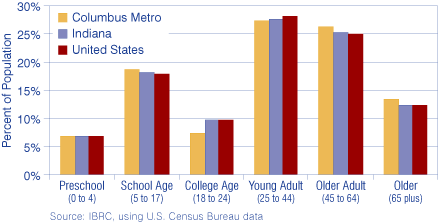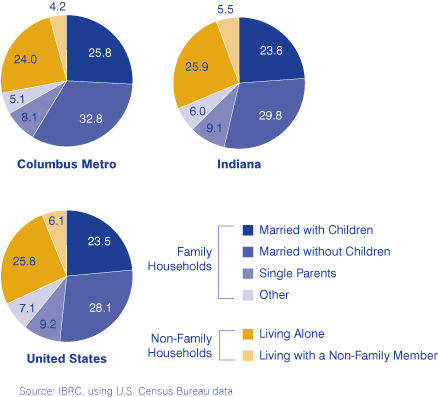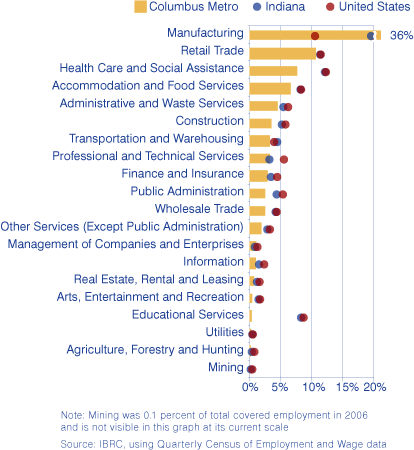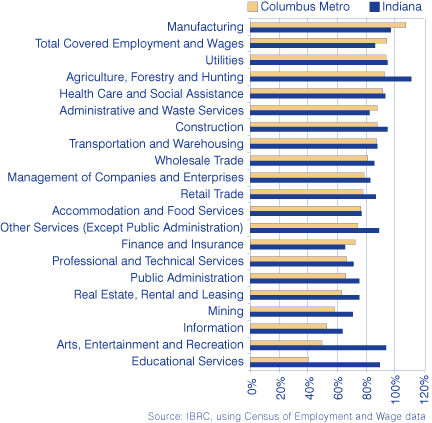The Columbus Metro Story: Told by STATS Indiana
This article is the sixth in a series of Indiana metro articles and will focus on the Columbus metro. All the data used in this writing are available using the USA Counties and Metros Side-by-Side feature on STATS Indiana (www.stats.indiana.edu).
The Area
Bartholomew County in and of itself is the Columbus metropolitan statistical area (metro). In 2007, about 74,750 people resided in the Columbus metro, a 17.4 percent increase since 1990. This growth rate is faster than Indiana (14.5 percent) but not as fast as the United States (21.2 percent) over that same time period. It is important to keep in mind for areas as small as the Columbus metro that higher percent changes are often due to a relatively small base (in this case, population).
The Columbus metro has a slightly older population than Indiana and the United States (see Figure 1). In fact, the median age for Bartholomew County was 37.7 in 2006, more than a year older than the Indiana median age of 36.3 and the U.S. median age of 36.4. If we dig a little deeper into the USA Counties and Metros Side-by-Side data, we get a better picture of the types of households living in the metro. The Columbus metro has a higher percentage of households classified as family households than does the state or nation. Single parents make up 8.1 percent of total households in the metro, while that number climbs to 9.1 percent in Indiana and 9.2 percent in the United States (see Figure 2).
Figure 1: Population by Age in the Columbus Metro, Indiana and the United States, 2006

Figure 2: Type of Households in the Columbus Metro, Indiana and the United States, 2000

Compared to the state and nation, the Columbus metro is densely populated, with about 184 people per square mile. Statewide, that figure is slightly lower at 177 people per square mile, and the United States averages 85 people per square mile. The metro's poverty rate (10 percent) is 2.2 percentage points lower than the state and 3.3 percentage points lower than the nation. Bartholomew County and Indiana both had higher high school graduation percentages than the United States. The Columbus metro led on this measure, with 83.8 percent of the population 25 and older holding at least a high school diploma. In Indiana, the percent of adults 25 and older with at least a high school diploma was slightly lower than the metro, coming in at 82.1 percent. For the United States, about eight of every 10 people in the 25-and-older category held a high school diploma.
Jobs and Wages
There were about 42,600 jobs in the Columbus metro in 2006. A whopping 36 percent of those jobs were in the manufacturing industry, by far the largest sector in the metro. Compare that number to Indiana's 19.6 percent of total employment in the manufacturing industry and the nation's 10.6 percent. As Figure 3 shows, retail trade was the second largest sector in Bartholomew County, employing slightly more than 4,500 workers (10.7 percent of total covered employment). Health care and social assistance, while still among the top three industry sectors, only employed 7.7 percent of workers in the metro compared to slightly more than 12 percent at both the state and national levels.
Figure 3: Jobs as a Percent of Total Covered Employment, 2006

Management of companies and enterprises paid the most among major industry sectors in the Columbus metro, averaging nearly $70,000 per year. However, this wage did not stack up so well against Indiana and U.S. wages for the industry, which paid $73,747 and $88,823, respectively. This seems to be a common theme among Columbus metro wages. Nine of the county's 20 major industries paid less than 75 percent of U.S. wages for that industry (see Figure 4). Manufacturing was the stronghold of the metro and was the only industry at the metro level to pay more on average than Indiana or the United States. Overall, total covered wages in the Columbus metro were $40,107, higher than Indiana's $36,553 but only 94.3 percent of U.S. wages.
Figure 4: Wages in the Columbus Metro and Indiana as a Percent of U.S. Wages, 2006

While looking at the jobs and wages data, we must keep in mind a few facts behind the numbers. For Quarterly Census of Employment and Wages (QCEW) data from the Bureau of Labor Statistics, some data are simply not published or not available. There are four different types of ownership for these data: private, local government, state government and federal government. When aggregated, they fall under the "total covered employment" category. However, the nondisclosure requirements for each type of ownership vary by area, meaning that data may not be disclosable at the local government level in Bartholomew County. For example, in the numbers discussed above for the Columbus metro, BLS nondisclosure requirements result in the exclusion of local government data in the following industries: health care and social assistance; transportation and warehousing; professional and technical services; real estate, rental and leasing; information; and arts, entertainment and recreation. Likewise, state government data are nondisclosable for the public administration industry and both state and local government data are nondisclosable for the educational services industry.
What does all this mean? While it is useful to compare jobs and wages across geographies, one must use caution when doing so. For example, educational services wage data for Columbus appear to be only 40.5 percent of U.S. wages. Does this mean teachers in Columbus earn less than half of what their U.S. counterparts make? The answer is no. If we go back to the BLS ownership breakouts, we find that the U.S. numbers include data from every ownership type and the Bartholomew County numbers only include private data. As a result, data in these specific cases are not directly comparable across geographies and warrant additional research.
Conclusion
The Columbus metro appears to be performing fairly well, increasing population at a faster pace than the state overall while maintaining a relatively low poverty rate and high percentages of its adult population that have earned a high school diploma or more. Manufacturing is especially prominent in the metro, providing more than one-third of all jobs in the area (more than the next five industries combined). The good news is that manufacturing also pays well in the metro and is the only industry in Bartholomew County that pays higher average annual wages than the United States. Although the manufacturing sector is a stronghold for the Columbus metro's jobs and wages, it is somewhat alarming that more than half of all the industry sectors in the area pay less than 80 percent of U.S. wages, since large swings in the manufacturing economy could easily be magnified in the metro.
Molly Manns, Associate Editor
Indiana Business Research Center, Kelley School of Business, Indiana University
